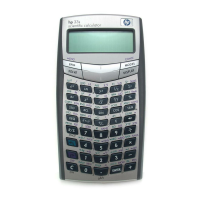Base Conversions and Arithmetic
10–3
File name 33s-English-Manual-040130-Publication(Edition 2).doc Page : 388
Printed Date : 2004/1/30 Size : 13.7 x 21.2 cm
If the result of an operation cannot be represented in 36 bits, the display shows
and then shows the largest positive or negative number possible.
Example:
Here are some examples of arithmetic in Hexadecimal, Octal, and Binary modes:
12F
16
+ E9A
16
=
?
Keys: Display: Description:
¹
¶
{
}
Sets base 16; HEX
annunciator on.
12F
Ï
E9A
Ù
Result.
7760
8
– 4326
8
=
?
¹
¶
{
}
Sets base 8; OCT
annunciator on. Converts
displayed number to octal.
7760
Ï
4326
Ã
Result.
100
8
÷ 5
8
=
?
100
Ï
5
¯
Integer part of result.
5A0
16
+ 1001100
2
=
?
¹
¶
{
} 5A0
_
Set base 16; HEX
annunciator on.
¹
¶
{
} 1001100
_
Changes to base 2; BIN
annunciator on. This
terminates di
it entry, so no
Ï
is needed between
the numbers.
Ù
Result in binary base.
¹
¶
{
}
Result in hexadecimal base.
¹
¶
{
}
Restores decimal base.

